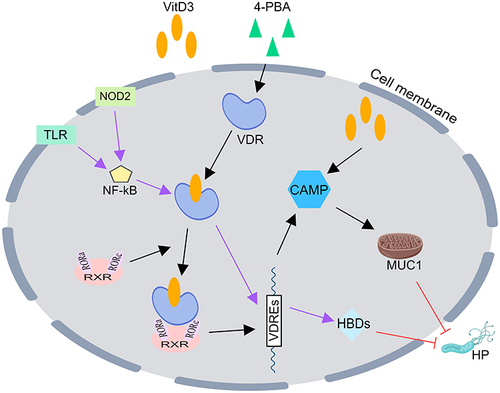Figures & data
Figure 1 VitD3 inhibits HP by promoting the secretion of antimicrobial peptides (AMPs). Vitamin D3 aloneCitation36 or in combination with retinoic acidCitation37 or 4-PBACitation35 results in the activation of functional VDR signaling to trigger the expression of CAMP, while VitD3 upregulates b-defensins by binding to VDR after TLR2/1 or NOD2 signaling activates NF-kB signaling in human monocytes, which ultimately eradicates HP.Citation38,Citation39 CAMP, cathelicidin antimicrobial peptide; HBDs, human β-defensins; VDR, vitamin D receptor; VDREs, vitamin D3 response elements; 4-PBA, 4-phenylbutyrate; TLR, Toll-like receptor; NOD2, nucleotide-binding oligomerization domain containing 2; NF-kB, nuclear factor kB; RXR, retinoid X receptor; ROR, retinoic acid-related orphan receptor; MUC1, mucin1.

Figure 2 The mechanism by which VitD3 enhances the lysosomal degradation of HP via Ca2+-dependent lysosomal acidification.Citation62 The membrane receptor PDIA3 is activated by VitD3 therapy, which also causes the PDIA3-STAT3 complex to relocate into the nucleus and upregulates MCOLN3 protein expression. This process restores Ca2+ release from lysosomes and causes lysosomal acidification. Lysosomes eliminate HP to restore the acidity of the environment. PDIA3, protein disulfide isomerase family A member 3; STAT3, signal transducer and activator of transcription 3; MCOLN3, mucolipin 3.

